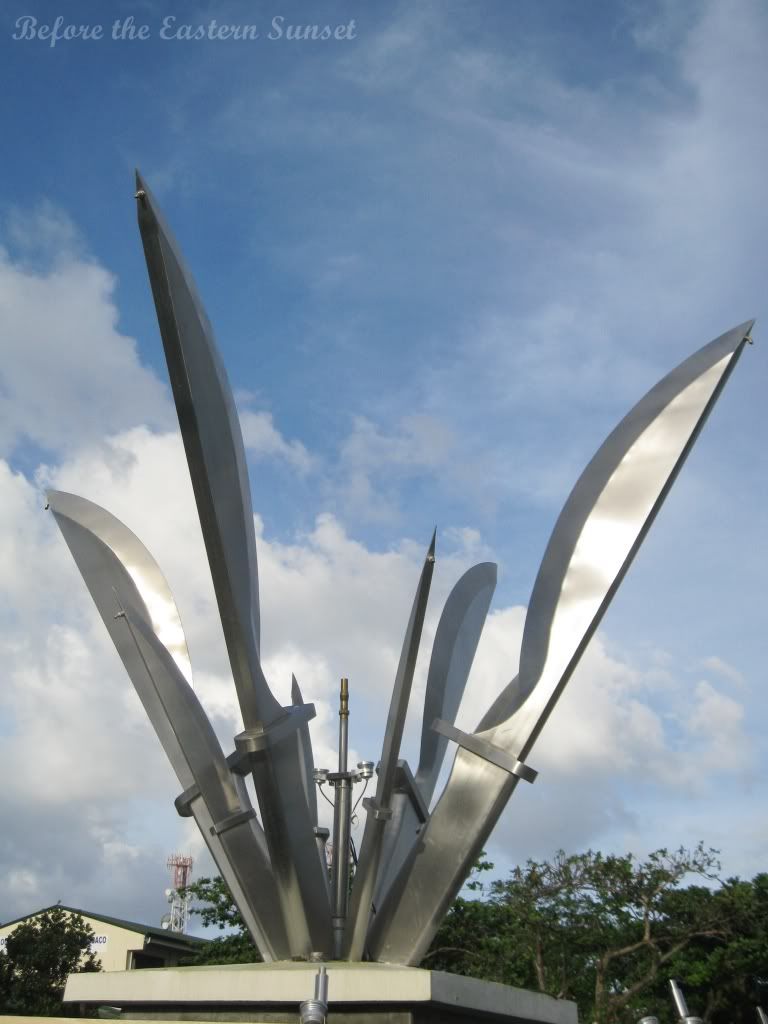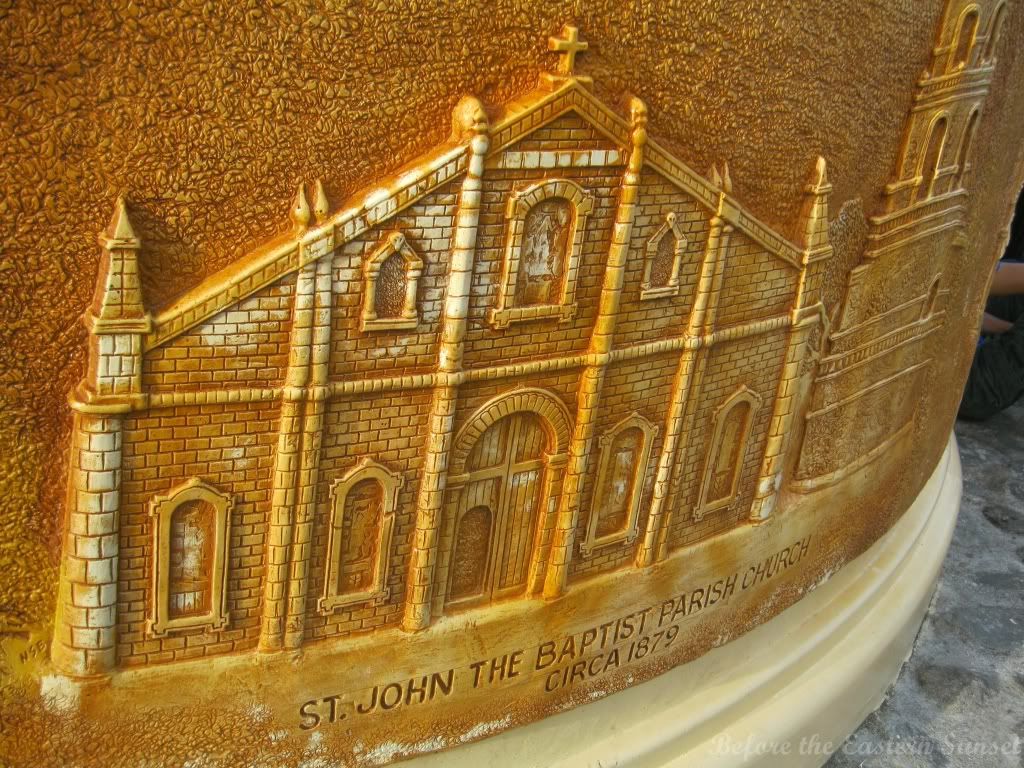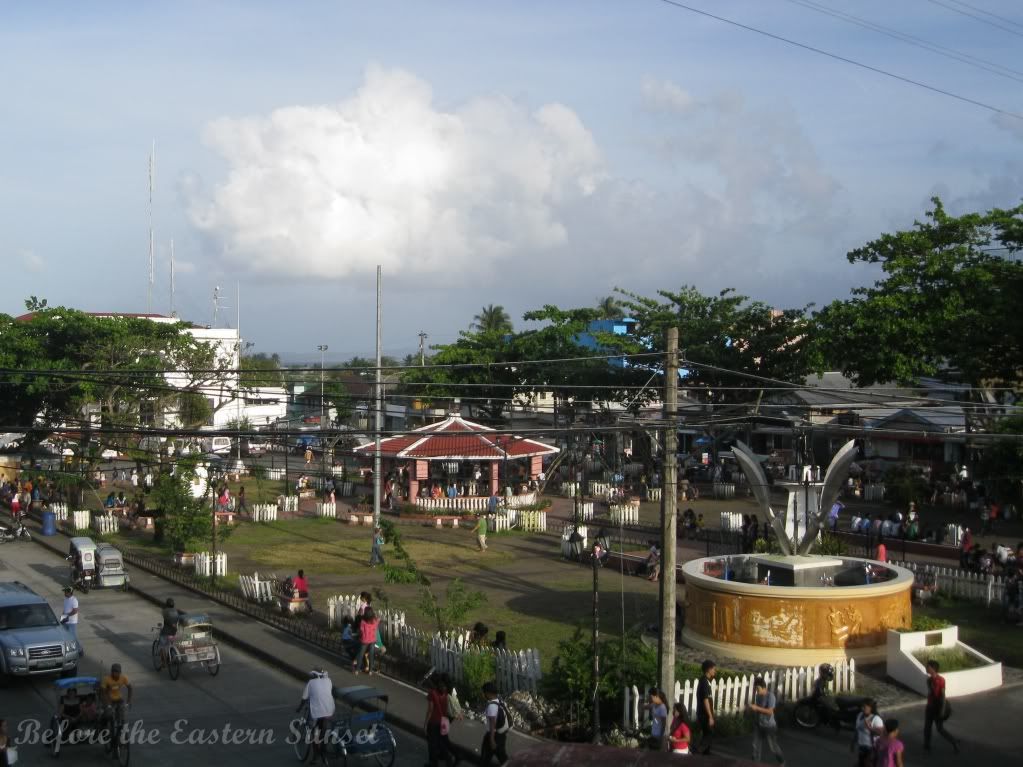Rows upon rows of tobacco plants is the first thought that came to my mind when I first heard about Tabaco City. That same thought also played in my mind while we were traveling from Bulan to Tabaco City. I imagined myself in the middle of a tobacco plantation with arms outstretched letting my palms touch tobacco plants while I walk.
I was confused when I reached Tabaco City after half-a-day journey from Bulan. What I saw at the city park is a monument of tabak, which is a big knife being crafted in this city.
.
The monument was established by the city government to show that the accepted origin of the Tabaco City's name came from the “Tabak ko! Tabak ko!” legend.
The legend says that some Spanish soldiers came to the place where Tabaco City now stood and asked a maiden about the name of the place. The overprotective father, thinking that the Spaniards will kidnap his daughter, shouted “Tabak ko! Tabak ko!” (My bolo! My bolo!). The Spaniards thought that the father is shouting the name of the place. Thus, the overprotective father's “Tabak ko” became Tabaco.
The legend supported by the Tabaco City government is very common and many places in the Philippines traced the origin of their name from the misunderstanding between the locals and Spaniards. Other historians claim that Tabaco City's name came from tobacco or tabaco as rendered in Spanish. Tobacco is the city's major product during the Spanish period.
I prefer the “tobacco” over the “tabak ko” etymology because it is more probable. Another reason is it's horrifying to imagine that I stand in the middle of a field of tabak with outstretched arms and my palms touching the blades. The tobacco plantation is more idyllic than a field of tabak.
Tabaco City began when Franciscan missionaries began their apostolic work in the area in 1587. Tabaco Church marked the flourishing of Catholicism in the area when its first structure was established in 1616. The church is one of the earliest structure in Tabaco City.
The heritage of Tabaco City was inscribed at the base of the Tabak Monument. Inscribed of course, is the Tabaco Church.
.
I will feature Tabaco Church in the next post.
Another heritage inscribed on the monument is tabak making.
.
I didn't buy any tabak in Tabaco City. I was worried that the tabak might be confiscated at the airport.
The inscription that caught my eye is this:
I never thought that a Chinese school could be found in Tabaco City. Tabaco Pei Ching High School was established in 1920. One of the popular alumni of this school is the showbiz writer Ricky Lo. Too bad that I failed to take a quick peek at this school.
The city park is the best place to stroll during dusk. Tabaqueños flock this park during the evening because it is located conveniently near the mall and Tabaco Church.
I stayed at this park in my first evening at Tabaco City. The air at park was cooler than our “airconditioned” room in a cheap hotel.
Another interesting building is a white house that I saw while I am on my way to Tabaco Port.
This white house is the house of the poetess Angela Manalang Gloria. I never know anything about this Filipina poet until I saw her house. Read more about Angela Manalang Gloria here.
The white house was established in the 19th Century by Mariano Villanueva. It was then owned and used as headquarters of Smith, Bell and Company. It was bought by the poetess in 1965. Aside from being the house of a poetess, this building was considered as one of the biggest house in Tabaco and the only remaining example of a house made of stone in Bicolandia dating to Spanish period.
It can be seen that Tabaco City is more prosperous than other towns, excluding Legazpi City, located around Mayon Volcano. The city is also rich in history and heritage. What made me sad is that the tobacco plantations are gone. My dream of touching tobacco plants didn't happen. I guess I have to go to Ilocos for that.









Such a beautiful town. No idea where it is exactly but it is really so nice. Love it!
ReplyDeleteSuitapui
ReplyDeleteThis place is located far to the south of Manila. It is not as popular as other places in the Philippines that's why you didn't its existence. :-)
astig nung monument ha
ReplyDeleteThe monument is so awesome! ;)
ReplyDeleteThe whole place looks like the old Pinas. :D I wonder if it feels the same as well.
MeCoy
ReplyDeleteAstig talaga 'yan. Sana nga lang pwedeng hugutin yung mga tabak at nang naiuwi ko sana.
Grysh
Tabaco City still feels like olf Pinas. It is catching up, however, because there are fast food restaurants like Mang Inasal and the ever-present Jollibee.
the cravings are so detailed! :)
ReplyDeleteLatest: Crazy Japanese Promo: ONLY RM16!
Tabak? What is that exactly? The inscriptions are beautiful!
ReplyDeleteFishiee
ReplyDeleteIt is! :-)
Foong
Tabak is just a bolo.
Nice pictures & story telling?..Mabuhay ka Kabayan!
ReplyDeleteMaraming salamat po. :-)
DeleteHow Tabaco got its name. It had nothing to do with tobacco or the tabak. As an advance party of Spanish soldiers were approaching the area they came to rest on its outskirts. While they rested they fell asleep, when they awoke, their horses were gone. They decided to walk and upon reaching the pueblo, there they saw their horses. They of course would want to know why their horses were there. Approaching a villager they greeted him and asked the name of the place. The villager answered “ata bako ako” meaning “it’s not me” thinking that he was being asked if he was the one who took the horses. And so it was that the Spaniards called the place Tabaco.
ReplyDeleteI am a citizen of tabaco city so i know the history of my place. All of the details given above were all true excluding that the origin of its name comes from tobacco. the truth is it came from the spaniards who misunderstood the datu for telling "TABAK KO" who means "ang tabak ko" that it is the name of the place. UNDERSTAND!!!!!!!!!!!!!!!!!!!!!!!!!!!!!!!!!!!! SANA NASABUTAN NINDO
DeleteI study very hard just to know the truth about our history so don't make it all wrong.
Thank you very much for your comment BUT I will stand by what I wrote here. I find it weird that many of the town in the Philippines got their name because of misunderstanding between the Spaniards and the natives. Such stories are so many that it made me think that people just created some of those stories just to explain the name of their town.
DeleteThe "Tabak" word was not used in this place when the Spaniards came, the blade weapon was referred to as "Sundang" it was only when there were already many migrants from other provinces that the word "Tabak" was used. I would go with the "ata bako ako" story.
Delete